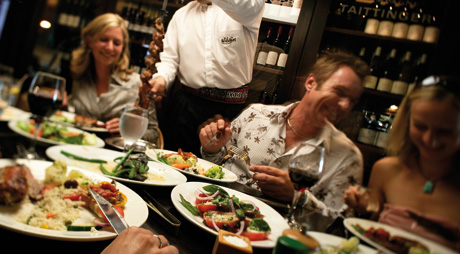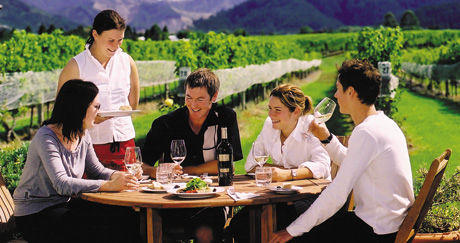Food, Wine & Shopping
Food
New Zealand’s dining culture has rapidly become one of the most sophisticated in the world, drawing on the influences of many different cultures to create a national menu that is vibrant, innovative and delicious! Although fish ‘n’ chips is still a popular Kiwi dish, New Zealand’s cuisine is increasingly multicultural, drawing inspiration from Europe, Asia and Polynesia. Fusion cuisine – a method blending flavours from around the Pacific Rim – is a fresh and vibrant style that has found its way to the style capitals of the world, thanks to trend-setting Kiwi chefs such as Peter Gordon and their award-winning restaurants. An abundance of high quality fresh produce is available on these shores – and off them: New Zealand seafood is incomparably fresh and full of flavour, offering many regional specialties such as Bluff oysters, West Coast whitebait and Kaikoura crayfish. Lamb is another iconic New Zealand product, while the local beef and cervena (farmed venison) are also of the highest quality. When it comes to cooking styles, relaxed is the key word. The essence of fusion cuisine is a casual approach which enables cooks to break with traditional formulas. Dining in New Zealand is generally an easy and unaffected time of pleasure and protocols are few. Throughout the year, when weather allows, al fresco is a popular way to dine. Cafés reflect this fact with tables extending into the garden or onto the pavement. The barbecue, another New Zealand favourite, is the quintessential combination of relaxed cooking and eating – on summer evenings the aromas of grilling food drift across suburban neighbourhoods. For a uniquely New Zealand take on outdoor dining, the hangi is another must-try. This traditional Maori way of cooking involves packing food into baskets, placing the baskets on hot rocks and burying them deep underground. The food, anything from meat and shellfish to vegetables, takes several hours to cook in its own steam. Maori foods can be sampled in many cultural attractions around the country, and taking part in a Maori banquet is an excellent way to get a real taste of New Zealand.
New Zealand Culinary SpecialtiesBeef and Lamb – New Zealand beef and lamb are of the highest quality and are exported worldwide. Due to a temperate climate, livestock are able to graze on fresh pasture year-round – and that makes New Zealand beef and lamb unique. For more information see www.newzealandbeef.org or www.newzealandlamb.org. Cheeses – the growing conditions of New Zealand’s livestock also result in an abundance of wonderful dairy products including cheese. A myriad of specialty cheeses are on offer and the local blue cheeses are particularly renowned. Crayfish – also known as Rock Lobster, crayfish are harvested in coastal waters around New Zealand and are utterly delicious. Gourmet Oils – relative newcomers to the list of New Zealand culinary specialties, local Olive and Avocado Oils are fresh and delicious. Green Lipped Mussels – delicious simply steamed, Green Lipped Mussels are native to New Zealand and are farmed in the Marlborough Sounds, The Coromandel and Stewart Island. Honey – many varieties of honey are available in New Zealand, but one of the most sought after is Manuka Honey. Manuka is a native flowering shrub and the honey produced by bees collecting its nectar is renowned for its health benefits. Hokey Pokey Ice Cream – creamy New Zealand ice cream is a must-try in any flavour, but hokey pokey, with its pieces of toffee, is a special favourite. King Salmon – salmon, available either fresh or smoked, is farmed in the Marlborough Sounds, Stewart Island and on the South Island’s east coast. Kiwifruit – also known as Chinese Gooseberry, Kiwifruit are succulent green-fleshed fruit with a furry brown skin that thrive in warmer parts of the country. Kumara – a traditional Maori food crop, Kumara (or sweet potato) is a delicious local favourite that may be served as chips, roasted or mashed. Lemon & Paeroa – New Zealand’s unique soft drink originates from the small North Island town of Paeroa. Pavlova – the traditional New Zealand dessert is a meringue that is crisp on the outside and soft in the middle, covered with cream and decorated with fruit.
Wine
Although wine has been produced in New Zealand since the arrival of the first European settlers, it is only in recent years that the industry has rapidly expanded – New Zealand is now becoming internationally recognised for producing wines of note. There are ten main wine-growing regions in New Zealand, although growers are constantly experimenting with new regional microclimates. Each growing area has a particular climate and terrain that produces a distinctive type of wine. The major growing areas are on the sunny and dry eastern parts of the country – Gisborne and Hawke’s Bay in the North Island and Marlborough in the South Island. Other important areas are Wairarapa in the north, and Nelson, Canterbury and Queenstown in the south. Gisborne, the Chardonnay capital of New Zealand, produces delicious examples of this popular wine, while the Hawke’s Bay has one of the longest traditions of wine-making in New Zealand. Its climate is perfect for grapes – a dry, sunny, long growing season makes for ripe fruit and high alcohol content! The Chardonnays from this part of the world are stunning and the reds are New Zealand’s best. Marlborough is the capital of New Zealand wine producing – many consider it the Sauvignon capital of the world. Hot sunny days and crisp nights, even in summer, intensify grape flavour and preserve acidity, making for stunningly intense Sauvignon Blancs. In Canterbury, a crisp climate makes for good Rieslings, Chardonnays and Sauvignon Blanc/Semillon blends. European wine-makers argue that great wine is grown in a challenging climate and Central Otago is living proof! Home to some of the southernmost vineyards in the world, here the emphasis is on Pinot Noir.
Shopping
New Zealand is a wonderful place for shopping, whether your clients’ tastes run to fine wine, original art, designer clothes or quirky souvenirs such as the Buzzy Bee pull-along toy, a much-loved national icon. Most visitors don’t come to New Zealand to shop, but once they’re here they can’t resist the high-quality and original products on offer. Your clients will find that there is a large variety of shops to visit, from international-style shopping malls to quirky, one-of-a-kind boutiques. For souvenirs, well-stocked gift shops are easy to find, and iconic New Zealand items come in a variety of prices; from an inexpensive pair of jandals to a jade necklace or Maori carving. For those wanting something a little bit special, something unique and authentically New Zealand, there are boutiques and galleries everywhere, from big cities to well off the beaten track. New Zealand has a great reputation for beautiful jewellery made from natural products like greenstone (jade) and paua (abalone shell), high quality wool and leather products, and cutting-edge fashion by local designers. Blended Merino wool and possum fur crafted into soft and wearable hats, gloves and other accessories is a local specialty, and a great way to keep warm if your clients are visiting in winter. For a real slice of authentic Aotearoa, they may like to purchase an original New Zealand artwork. Encourage your clients to leave plenty of room in their suitcases, because they’re likely to be very pleasantly surprised by the shopping on offer in New Zealand. Shopping Hours |
|



